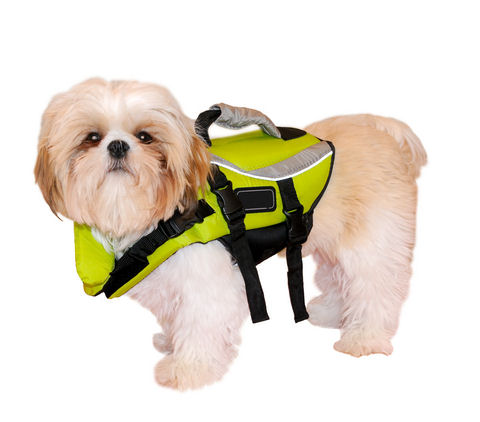Would you be prepared if a tornado swept through your community tomorrow? What would you do if you experienced a flood as catastrophic as the one in Memphis? Could you keep your family and pets safe if you experienced a quake like the one in Japan?
With today’s prevalence of natural disasters and the tragedy that comes with, we must be able to answer these questions with confidence and prioritize disaster preparedness efforts—for humans and animals alike. June has been designated as Disaster Preparedness Month for Animals to encourage people to think about the course of action they would take in keeping themselves and their pets safe before they are devastated by a natural disaster. Summertime carries with it the threat of hurricanes, tornadoes, wildfires and other natural disasters that can be prepared for in advance with a little preparation and a lot of common sense.
National DisastersAlthough this dog was kept safe after the Joplin, Missouri tornadoes, countless animals were lost or are missing.
Before the disaster
The best thing you can do in the event of a disaster is be prepared. Follow these steps ahead of time to make sure that your precious pets will be accounted for in times of calamity.
First, make sure you have a designated “safe” place in your home for all family members and pets if the disaster does not require you to evacuate. It’s best that this safe place be away from windows and doors and located toward the center of your home. Usually a basement or centrally-located bathroom is safest. Also prepare for an event that will require you to flee your home. Disasters such as fires and hurricanes will make it necessary to get away from your home and to a place of refuge as quickly as possible. Unfortunately, your pet may not be able to stay with you. For this reason, make a list of animal shelters, boarding facilities and pet-friendly hotels that are prepared to house animals and evacuate them if needed.
Then talk with your family and neighbors to make sure everyone is on board with the plan. Designate someone to be in charge of retrieving pets from the house or anywhere else they may be.
Also keep your pet’s identification up-to-date. Pets can be displaced for miles after a disaster, making them almost impossible to find on your own. If your pet has proper identification containing your name, phone number, address and the contact information of someone out of state (in case you are displaced as well), your pet is more likely to be recovered and returned to you.
Make sure to gather any relief plans and emergency materials available from your local Red Cross chapter or police, fire, health and agriculture departments. This will ensure that you know where to turn in an emergency situation and will have access to the best resources.
Next, make known that your house is home to animals. Purchase a pet rescue window sticker to place on your entry doors to ensure your pets are not left without help. If you and your family have to evacuate your home before rounding up your pets, this sticker will alert emergency officials that there are pets inside in need of rescue. It is beneficial to list your pet’s names and favorite hiding places on the sticker, as well a quality picture of each animal.
Finally, create an emergency kit. This kit should contain everything you might possibly need after disaster that puts you out of a home. Prepare this pet survival kit in a waterproof container or your pet’s travel carrier. If you opt for the carrier, make sure it is large enough for an animal to stand up and turn around in, guaranteeing their comfort in such a stressful situation. Keep this kit always-prepared and near a means of exit to make it easy to grab on your way out of the house. Make sure it includes:
At least two weeks of any medication your pet is taking
Flea prevention and heartworm treatment
Two weeks’ worth of pet food and water
Bowls/containers for the food and water
Treats, toys and blankets
Extra leashes and collars
Muzzle
Pet safety flotation halters or vests if in a flood zone
Peroxide
Gauze, bandages and adhesive tape
Training pads (if you aren’t able to be outside safely) and cat litter
Paper towels and hand towels
Your pet’s vaccination records
The contact information of your vet
Your pet’s identification with your contact info (think about getting your animal micro-chipped)
Contact information of pet-friendly hotels and shelters
Pictures of your pet with a good description
Portable radio to listen for PSAs regarding emergency news and available refuge
Watch this video for a pet survival kit tutorial from the American Veterinary Medical Association.
During the disaster
When disaster strikes, make sure you are prepared to act. Utilize your preparedness kit and disaster relief plan to get your entire family to safety.
If you must evacuate, do so immediately. Waiting until the last minute may mean it’s too late to take your pet with you. Keep up on the latest emergency information and breaking news, if possible, and be sure you know where your pet is at all times. When animals sense disaster, they tend to hide, making finding and evacuating them close to impossible. Keep them close by and on a leash when preparing to evacuate or take shelter in your own home.
Stay calm. Whether you are fleeing home or taking cover in your safe place, remain as composed as possible to create a familiar and comfortable environment for your pet. If an animal acts out or becomes uncomfortable, hold them or keep them safe in their carrier or cage.
After the disaster
After it is okay to exit your safe place at home or after you have made it to a nearby shelter or hotel, follow these guidelines to remain comfortable or to recover a missing or suffering pet.
Keep in mind that your pet is likely to be disoriented after being outside in a disaster or even afterward. A lack of familiar sights and smells can inflict stress on them or increase their chances of becoming lost. Keep your pet on a leash and/or in your arms until they become comfortable with the surroundings or until they are no longer expressing aggression or misbehaving. Reassure your pet with familiar petting, cuddling and patience.
Take note of the condition of your pet, making sure they are not injured, sick or hungry. Utilize your pet survival kit to administer any medications, wound care or to keep them nourished. If you need to, refer to your list of veterinarians to contact for further assistance.
If you have become separated from your pet, stay calm, ask for help and visit local shelters, animal control facilities and kennels on a daily basis. Use the picture and description of your pet to create “missing” posters and show the people around you. If your pet has not gone far, they may be able to match your description to the pet you’ve been looking for. Know that collars and tags are sometimes lost, so tattoos, markings or microchips will increase the odds of your pet being found.
If you happen to find another stray animal, take it to a shelter immediately and place its information around town, online and in the newspapers to increase the chances of a pet-owner reunion.
Do your part to prioritize disaster preparedness efforts for animals this month—prepare a pet survival kit, share this information or donate to an animal rescue mission today. More than 800 animals were displaced by the Joplin, Missouri tornadoes this year, more than 10,000 were lost in the force of Hurricane Katrina and so many others have never been recovered in times of catastrophe. Disaster can strike anywhere, anytime—make sure your pet is prepared.

